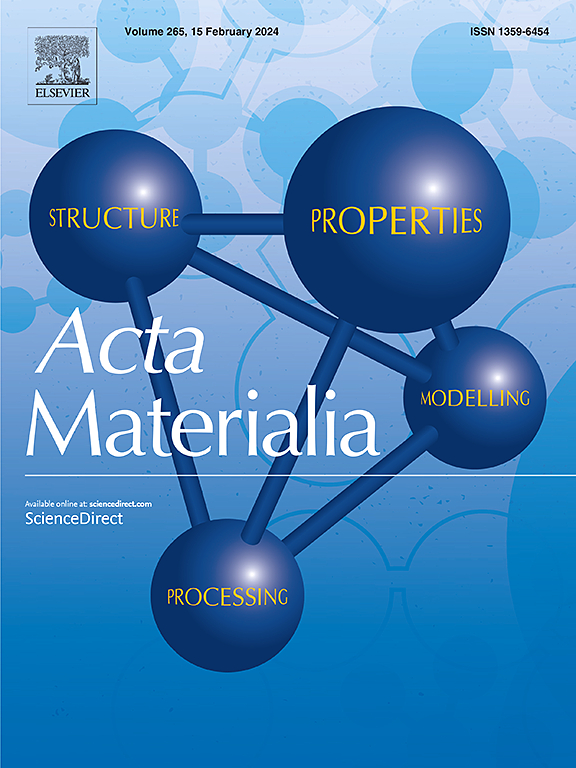成分各向异性参数对Ni-Nb合金枝晶形成模式的影响
IF 8.3
1区 材料科学
Q1 MATERIALS SCIENCE, MULTIDISCIPLINARY
引用次数: 0
摘要
采用毛细管波动法计算了成分在11.46 at以下的Ni-Nb合金的固液界面能和各向异性参数。% Nb。尽管存在较大的原子尺寸失配和能量不对称,但Ni-Nb体系没有表现出异常的界面能行为。分析界面附近的数密度峰,并与Al-Sm和Cu-Zr体系进行比较,发现低溶解度导致原子层错位和界面能改变,强调了界面附近的构型熵变化的作用。分子动力学模拟和Bridgman定向凝固实验表明,随着Nb含量的增加,从< 100 >到海藻结构的形态转变依赖于成分。紧凑的海藻进化成稳定的双球阵列,具有很强的定向秩序,分裂主要限制在< 100 >方向附近,这一点在反向极点图中< 100 >极点附近的分散密度峰值得到了证实。EBSD分析进一步表明,随热梯度的生长失调对杜布隆和倾斜海藻的微观结构有显著影响,而对直的< 100 >的树突影响最小。这突出了成分相关的各向异性在破坏枝晶尖端稳定和驱动Nb加入后的微观结构转变中的内在作用。此外,三维相场模拟阐明了倾斜海藻中的三质子分裂机制,并强调了al基合金中Ni-Nb双布隆与典型各向同性海藻形态之间的差异,重点关注了< 100 >的界面能较大和< 100 >的刚度较低。结果强调,取向选择图上显示的< 100 >的界面各向异性残余可以指导有序的分裂模式,尽管各向异性强度总体上有所降低。本文章由计算机程序翻译,如有差异,请以英文原文为准。


Effect of composition-dependent anisotropy parameters on the dendrite formation patterns in Ni-Nb alloy
Solid-liquid interfacial energy and anisotropy parameters of Ni-Nb alloys were calculated using capillary fluctuation method for compositions up to 11.46 at.% Nb. Despite the large atomic size mismatch and energy asymmetry, the Ni-Nb system showed no anomalous interfacial energy behavior. Analysis of number density peaks near the interface, combined with comparisons to Al-Sm and Cu-Zr systems, revealed that low solubility contributes to misaligned atomic layers and altered interfacial energy, emphasizing the role of configurational entropy variations near the interface. Molecular dynamics simulations and Bridgman directional solidification experiments demonstrated a compositional-dependent morphological transition from 〈100〉 to seaweed structures as Nb content increased. Compact seaweed evolved into stable doubloon arrays exhibiting strong orientational order, splitting predominantly constrained near the 〈100〉 direction, as confirmed by the disperse density peaks around 〈100〉 pole in inverse pole figures. EBSD analyses further showed that growth misalignment with thermal gradient significantly influenced microstructures with doubloons and tilted seaweeds, while having minimal effect on straight 〈100〉 dendrites. This highlights the intrinsic role of composition-dependent anisotropy in destabilizing dendrite tips and driving microstructure transitions with Nb addition. Additionally, 3D phase field simulations clarified the triplon-based splitting mechanism in tilted seaweeds and highlighted differences between Ni-Nb doubloons and typical isotropic seaweed morphologies in Al-based alloys, focusing on the bigger 〈100〉 interfacial energy and lower 〈100〉 stiffness. The results emphasize that the residual 〈100〉 interfacial anisotropy shown on the orientation selection map could guide ordered splitting patterns despite an overall reduction in anisotropy strength.
求助全文
通过发布文献求助,成功后即可免费获取论文全文。
去求助
来源期刊

Acta Materialia
工程技术-材料科学:综合
CiteScore
16.10
自引率
8.50%
发文量
801
审稿时长
53 days
期刊介绍:
Acta Materialia serves as a platform for publishing full-length, original papers and commissioned overviews that contribute to a profound understanding of the correlation between the processing, structure, and properties of inorganic materials. The journal seeks papers with high impact potential or those that significantly propel the field forward. The scope includes the atomic and molecular arrangements, chemical and electronic structures, and microstructure of materials, focusing on their mechanical or functional behavior across all length scales, including nanostructures.
 求助内容:
求助内容: 应助结果提醒方式:
应助结果提醒方式:


